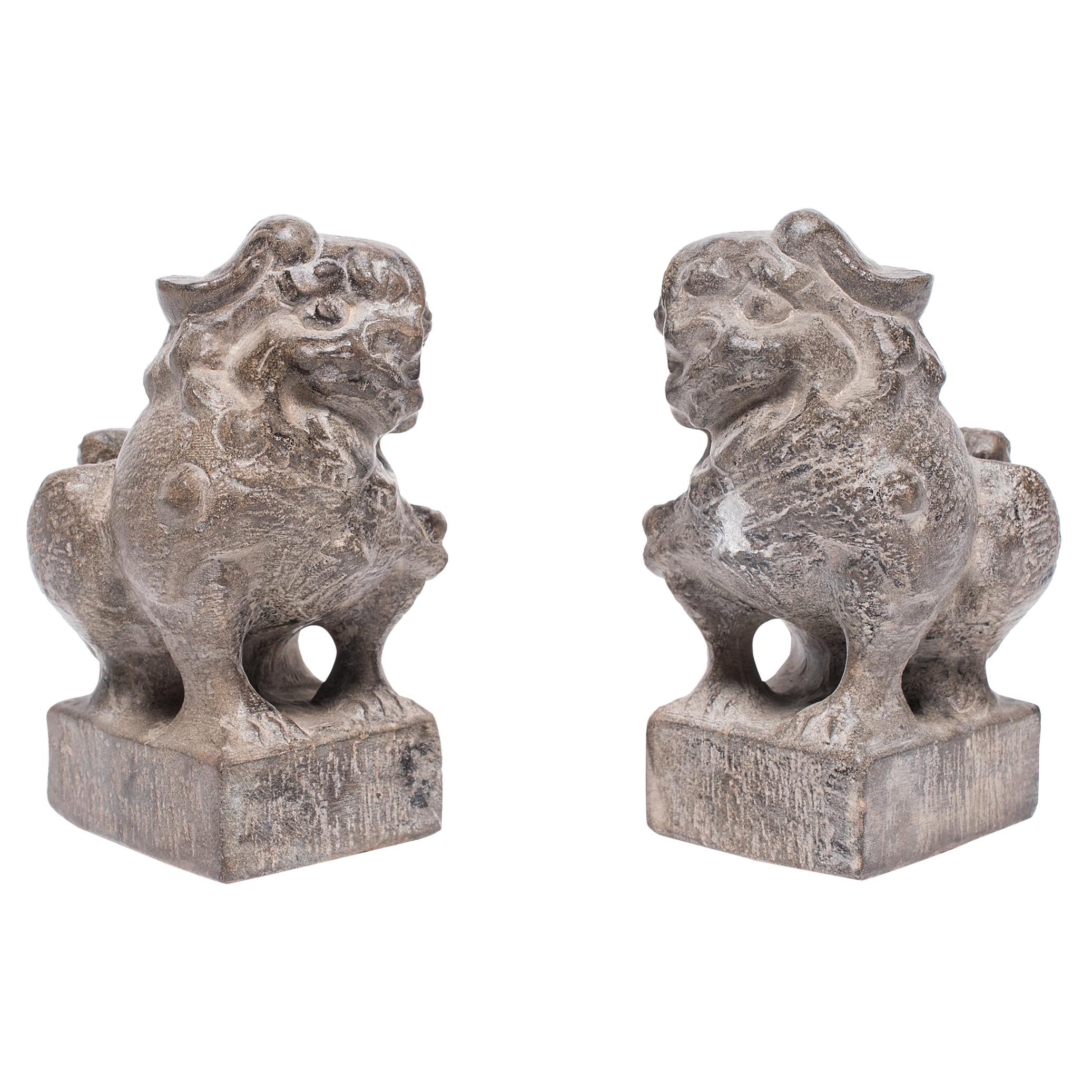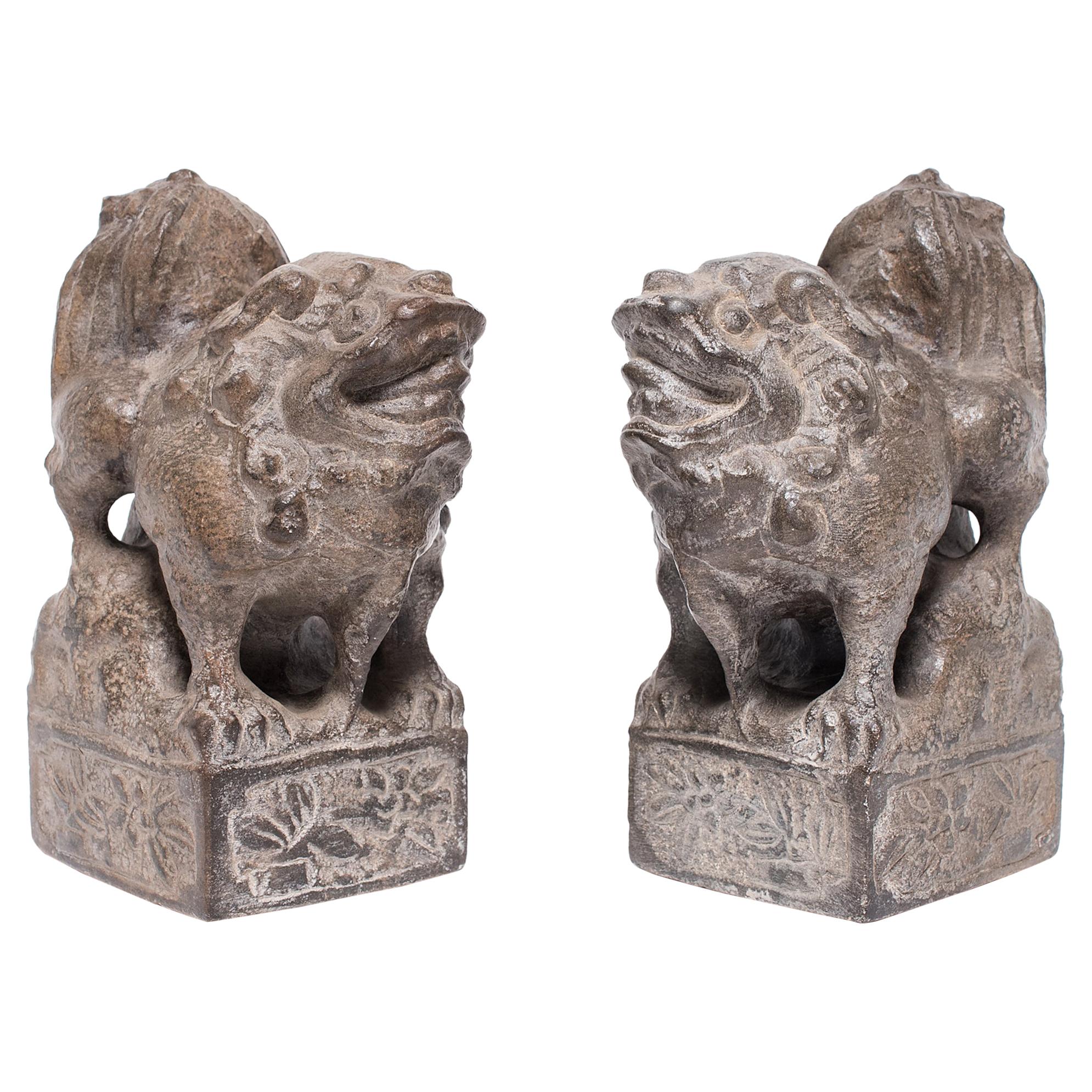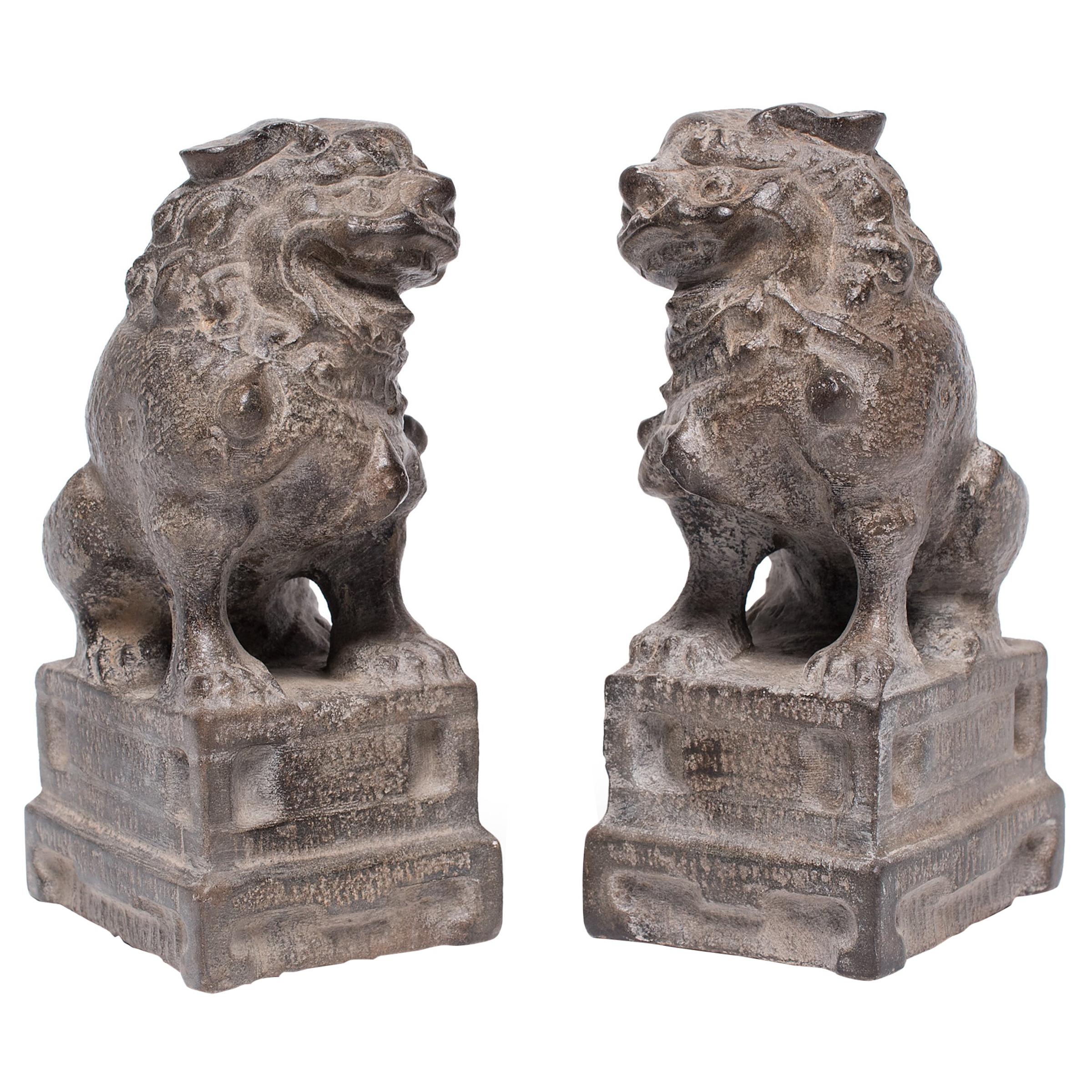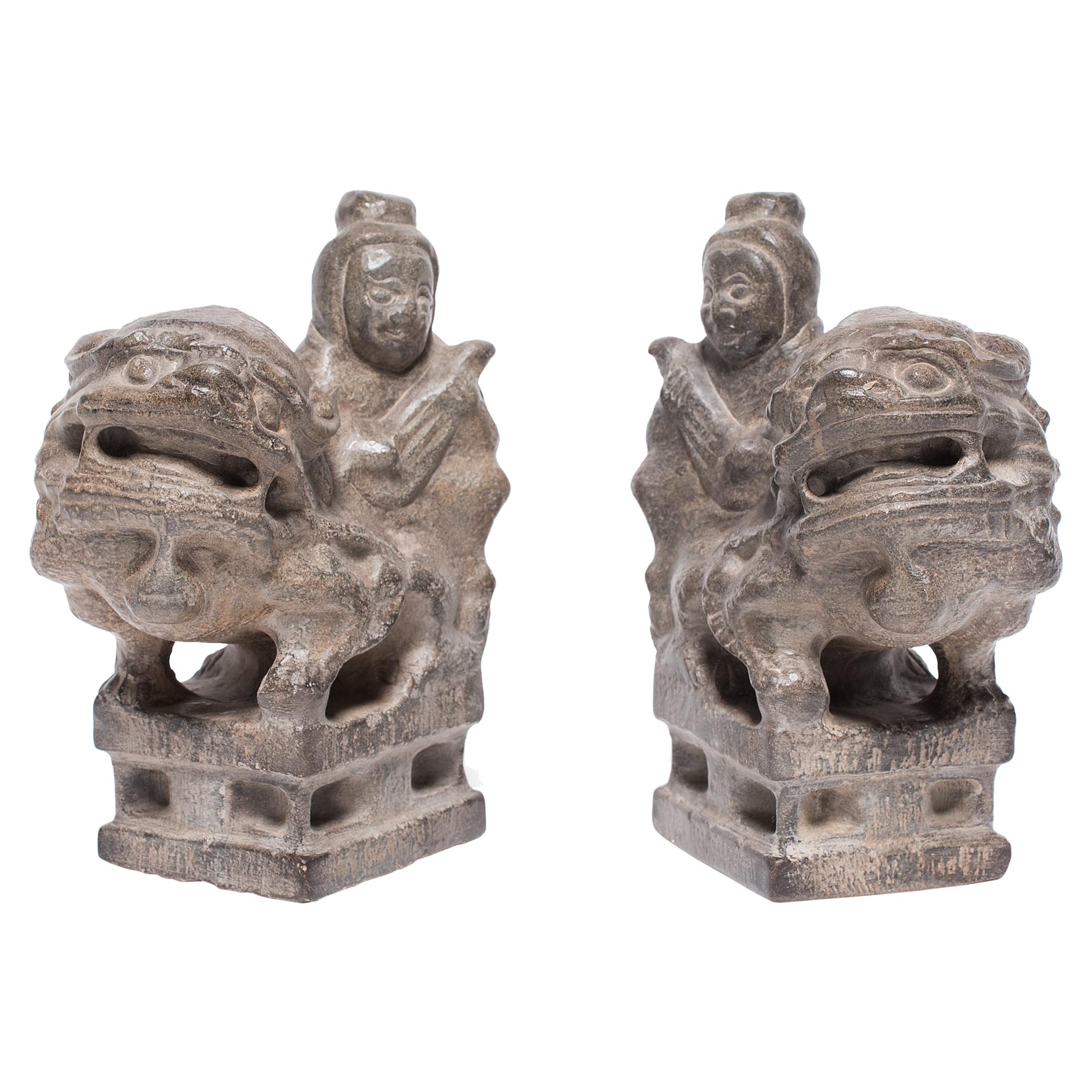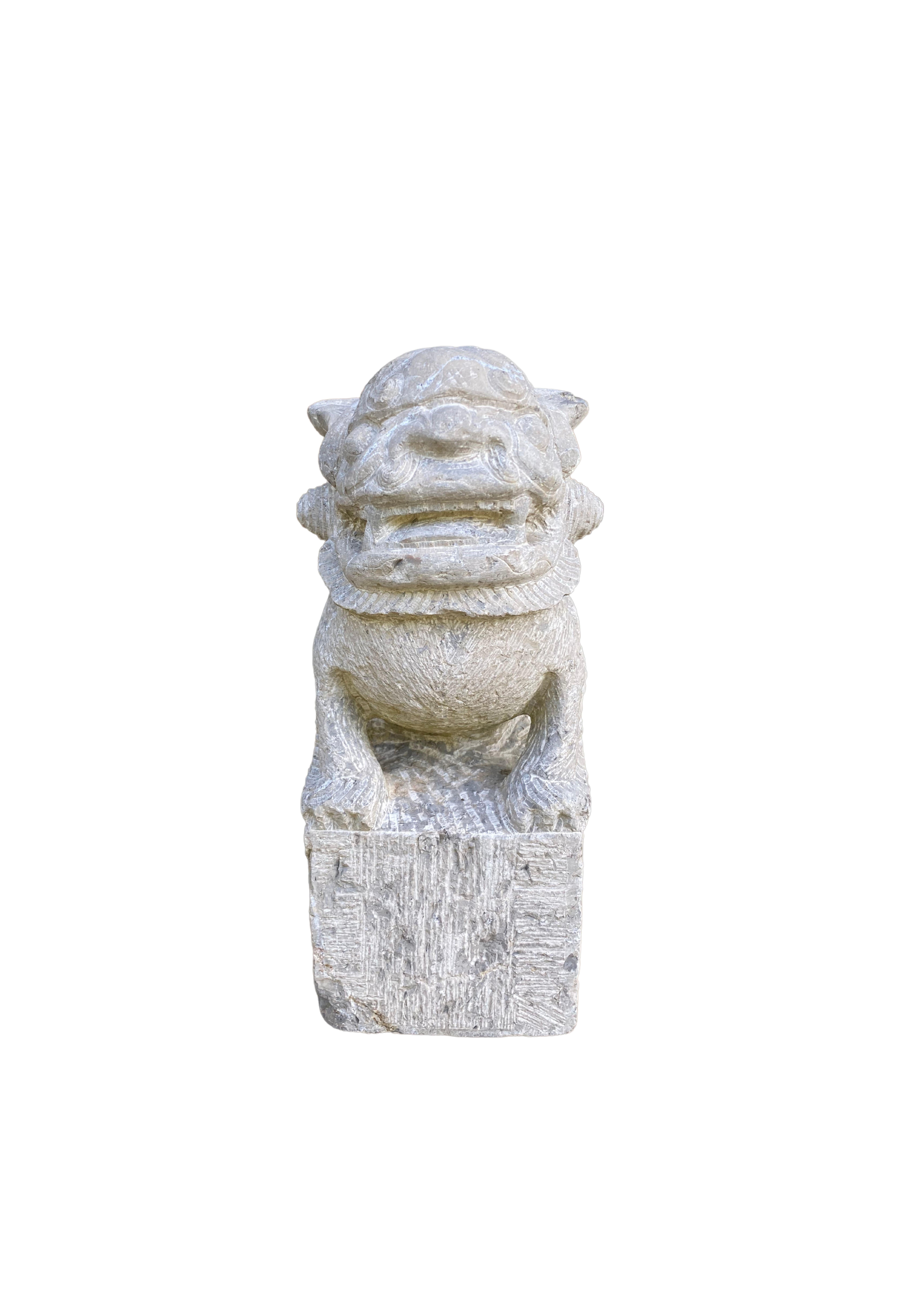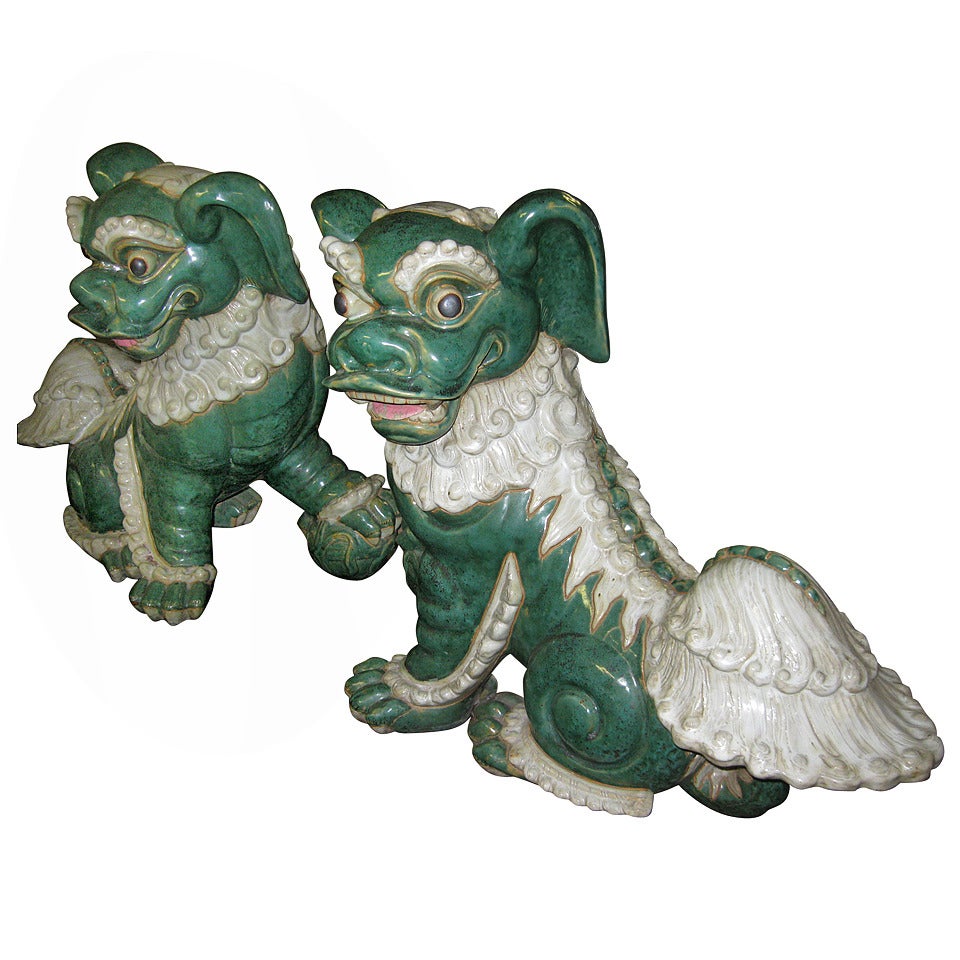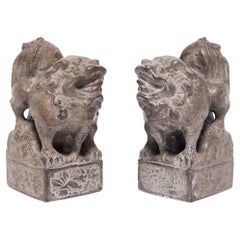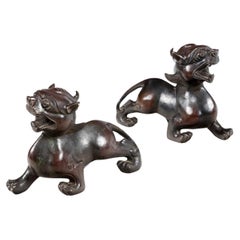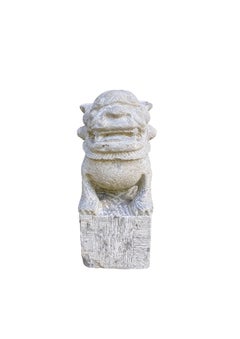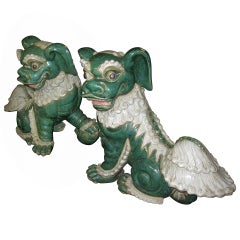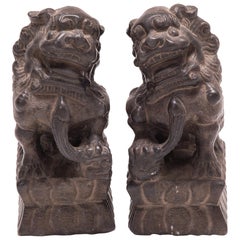
Pair of 19th Century Chinese Guardian Fu Dogs
View Similar Items
Want more images or videos?
Request additional images or videos from the seller
1 of 11
Pair of 19th Century Chinese Guardian Fu Dogs
About the Item
- Dimensions:Height: 9 in (22.86 cm)Width: 6 in (15.24 cm)Depth: 4 in (10.16 cm)
- Sold As:Set of 2
- Style:Qing (Of the Period)
- Materials and Techniques:
- Place of Origin:
- Period:
- Date of Manufacture:1850
- Condition:Wear consistent with age and use.
- Seller Location:Chicago, IL
- Reference Number:Seller: BJG0131stDibs: LU820013300352

About the Seller
4.9
PAGODA RED is a renowned resource for designers as well as collectors of contemporary and ancient Chinese, Korean and Japanese art. They offer a curated edit of fine and provincial furniture, ceramics, scholars' objects, and paintings and textiles, each piece historically and geographically authentic.
Diamond Seller
These expertly vetted sellers are 1stDibs' most experienced sellers and are rated highest by our customers.
Established in 1997
1stDibs seller since 2006
1,412 sales on 1stDibs
Typical response time: 1 hour
More From This SellerView All
- Pair of 19th Century Chinese Stone Fu DogsLocated in Chicago, ILThis pair of 19th century carved limestone Fu dogs with sinister smiles and furled brows once guarded the entrance to one of provincial China's grand homes. One peers up and the othe...Category
Antique Mid-19th Century Chinese Qing Sculptures and Carvings
MaterialsLimestone
$9,680 / set - Pair of Petite Chinese Fu Dog GuardiansLocated in Chicago, ILWith curly manes, fluffy tails, and playful expressions, these petite stone fu dogs are adorable companions and benevolent guardians of the home. Also known as shizi, the pair repres...Category
21st Century and Contemporary Chinese Sculptures and Carvings
MaterialsLimestone
$880 / set - Pair of Petite Chinese Fu Dog GuardiansLocated in Chicago, ILWith curly manes, fluffy tails, and playful expressions, these petite stone fu dogs are adorable companions and benevolent guardians of the home. Also known as shizi, the pair repres...Category
21st Century and Contemporary Chinese Sculptures and Carvings
MaterialsLimestone
$580 / set - Pair of Petite Chinese Fu Dog GuardiansLocated in Chicago, ILWith curly manes and playful expressions, these petite stone fu dogs are adorable companions and benevolent guardians of the home. Also known as shizi, the pair represents yin and ya...Category
21st Century and Contemporary Chinese Sculptures and Carvings
MaterialsLimestone
$680 / set - Pair of Petite Chinese Fu Dog Guardians with RidersLocated in Chicago, ILWith curly manes and playful expressions, these petite stone fu dogs are adorable companions and benevolent guardians of the home. Also known as shizi, the pair represents yin and ya...Category
21st Century and Contemporary Chinese Sculptures and Carvings
MaterialsLimestone
- 18th Century Chinese Guardian SculptureLocated in Chicago, ILThis ancient stone guardian lion shizi was carved by hand out of a single block of limestone. The artisan beckoned the guardian out from the stone, manipulating the unyielding materi...Category
Antique Early 18th Century Chinese Qing Sculptures and Carvings
MaterialsLimestone
You May Also Like
- Pair 19th Century Bronze Fu DogsLocated in Dublin 8, IEThese guardian statues were traditionally found standing sentry in front of palaces, temples, and homes of the elite across many parts of Asia. These ...Category
Antique 19th Century Asian Chinese Export Sculptures and Carvings
MaterialsBronze
$6,318 / set - Limestone Fu Dog Guardian Figure from China, c. 1900Located in Jimbaran, BaliThis limestone carving depicts a Fu Dog Guardian figure and was carved from a solid block. Sculptures such as these were used to protect ones home from bad spirits or bad luck. They ...Category
Mid-20th Century Chinese Qing Figurative Sculptures
MaterialsLimestone
$960 Sale Price / set20% Off - Late 19th century Pair of Glazed Porcelain Foo DogsLocated in Savannah, GAExtraordinary pair of fine glazed porcelain Foo dogs came to us out of an estate here in Savannah, Georgia, belonging to an old general that long ago brought them from Thailand. Used...Category
Antique 1890s Chinese Qing Sculptures and Carvings
MaterialsPorcelain
$27,500 / set - Pair of Antique Chinese Fu DogsLocated in Point Richmond, CAChinese pair of wood carved Fu Dogs, rendered from a single block of hardwood each, with exquisite detailing in a naive style, the dogs are opposing, crouched on their haunches, each...Category
Antique Early 19th Century Chinese Qing Sculptures and Carvings
MaterialsHardwood
- Antique 19th Century Chinese Hand-Carved Stone Guardian SculptureLocated in Yonkers, NYA 19th century Chinese carved guardian statue used as ship ballast. In the time when great wooden ships dominated the trade among nations of the east,...Category
Antique 19th Century Chinese Sculptures and Carvings
MaterialsStone
$11,249 Sale Price25% Off - A pair of 19th Century carved Foo temple dogs or Chinese guardian LionsLocated in London, GBChinese guardian lions, or imperial guardian lions, are a traditional Chinese architectural ornament. Typically made of stone, they are also known as stone lions or shishi (石獅; shíshī). They are known in colloquial English as lion dogs or foo dogs / fu dogs. The concept, which originated and became popular in Chinese Buddhism, features a pair of highly stylized lions—often one male with a ball and one female with a cub—which were thought to protect the building from harmful spiritual influences and harmful people that might be a threat. Used in imperial Chinese palaces and tombs, the lions subsequently spread to other parts of Asia including Japan (see komainu), Korea, Philippines, Tibet, Thailand, Myanmar, Vietnam, Sri Lanka, Nepal, Cambodia, Laos, and Malaysia. There has been extensive interaction between Chinese mythology and Confucianism, Taoism, and Buddhism. Elements of pre-Han dynasty mythology such as those in Classic of Mountains and Seas were adapted into these belief systems as they developed (in the case of Taoism), or were assimilated into Chinese culture (in the case of Buddhism). Elements from the teachings and beliefs of these systems became incorporated into Chinese mythology. For example, the Taoist belief of a spiritual Paradise became incorporated into mythology as the place where immortals and deities used to dwell. Sometimes mythological and religious ideas have become widespread across China's many regions and diverse ethnic societies. In other cases, beliefs are more limited to certain social groups, for example, the veneration of white stones by the Qiang. One mythological theme that has a long history and many variations involves a shamanic world view, for example in the cases of Mongolian shamanism among the Mongols, Hmong shamanism among the Miao people, and the shamanic beliefs of the Qing dynasty from 1643 to 1912, derived from the Manchus. Politically, mythology was often used to legitimize the dynasties of China, with the founding house of a dynasty claiming a divine descent. Mythology and philosophy. Further information: Chinese philosophy True mythology is distinguished from philosophical treatises and theories. Elaborations on the Wu Xing are not really part of mythology, although belief in five elements could appear. The Hundred Schools of Thought is a phrase suggesting the diversity of philosophical thought that developed during the Warring States of China. Then, and subsequently, philosophical movements had a complicated relationship with mythology. However, as far as they influence or are influenced by mythology, divides the philosophical camps into two rough halves, a Liberal group and a Conservative group. The liberal group being associated with the idea of individuality and change, for example as seen in the mythology of divination in China, such as the mythology of the dragon horse that delivered the eight bagua diagrams to Fu Xi, and methods of individual empowerment as seen in the Yi Jing (Book of Changes). The Liberal tendency is towards individual freedom, Daoism, and Nature. The relationship of the Conservative philosophies to mythology is seen in the legendary Nine Tripod Cauldrons, mythology about the emperors and central bureaucratic governance, Confucianism, written histories, ceremonial observances, subordination of the individual to the social groups of family and state, and a fixation on stability and enduring institutions. The distinction between the Liberal and Conservative is very general, but important in Chinese thought. Contradictions can be found in the details, however these are often traditional, such as the embrace by Confucius of the philosophical aspects of the Yi Jing, and the back-and-forth about the Mandate of Heaven wherein one dynasty ends and another begins based according to accounts (some of heavily mythological) where the Way of Heaven results in change, but then a new ethical stable dynasty becomes established. Examples of this include the stories of Yi Yin, Tang of Shang and Jie of Xia or the similar fantastic stories around Duke of Zhou and King Zhou of Shang. Mythology exists in relationship with other aspects of society and culture, such as ritual. Various rituals are explained by mythology. For example, the ritual burning of mortuary banknotes (Hell Money), lighting fireworks, and so on. A good example of the relationship of Chinese mythology and ritual is the Yubu, also known as the Steps or Paces of Yu. During the course of his activities in controlling the Great Flood, Yu was supposed to have so fatigued himself that he lost all the hair from his legs and developed a serious limp. Daoist practitioners sometimes incorporate a curiously choreographed pedal locomotion into various rituals. Mythology and practice, one explains the other: in these rituals, the sacred time of Yu merges with the sacral practice of the present. Various ideas about the nature of the earth, the universe, and their relationship to each other have historically existed as either a background or a focus of mythologies. One typical view is of a square earth separated from a round sky by sky pillars (mountains, trees, or undefined). Above the sky is the realm of Heaven, often viewed of as a vast area, with many inhabitants. Often the heavenly inhabitants are thought to be of an "as above so below" nature, their lives and social arrangements being parallel to those on earth, with a hierarchical government run by a supreme emperor, many palaces and lesser dwellings, a vast bureaucracy of many functions, clerks, guards, and servants. Below was a vast under ground land, also known as Diyu, Yellow Springs, Hell, and other terms. As time progressed, the idea of an underground land in which the souls of the departed were punished for their misdeeds during life became explicit, related to developments in Daoism and Buddhism. The underground world also came to be conceived of as inhabited by a vast bureaucracy, with kings, judges, torturers, conductors of souls, minor bureaucrats, recording secretaries, similar to the structure of society in the Middle Kingdom (earthly China). Chinese temple Dogs...Category
Antique 1860s Chinese Chinese Export Sculptures and Carvings
MaterialsHardwood


